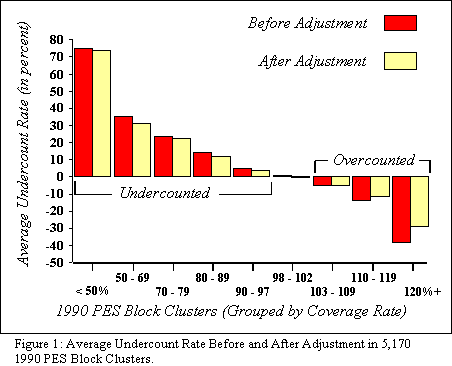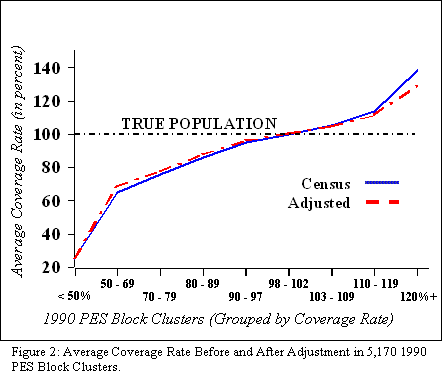| The Myth: Statistical Adjustment Will Correct Severe Undercounts in Predominantly Minority Neighborhoods For more than 10 years, the country has debated the use of “statistical adjustment” to resolve the problems of undercounting endemic to the decennial census – particularly in minority neighborhoods. The January 1999 Supreme Court ruling in large measure settled this debate by requiring the Census Bureau to attempt a full (100 percent) enumeration for the apportionment of seats in the U.S. House of Representatives.
The Administration and the Census Bureau, however, have insisted that statistical adjustment be used for all other purposes, including the allocation of federal and state funds for a variety of uses, from roads and schools, to health care and community development. The primary purpose of statistical adjustment is “to measure and correct overall and differential coverage of U.S. residents in Census 2000.”1 Presumably, this includes correcting the disproportionate undercount of African Americans, Asians, Latinos and Native Americans.
However, a new study, undertaken by the Congressional members of the U.S. Census Monitoring Board, reveals the ability of statistical adjustment to correct the undercount has been wildly overstated. The evidence clearly indicates that:- Statistical adjustment will not correct large undercounts or overcounts in small areas such as blocks and neighborhoods.
- Heavily undercounted areas will remain heavily undercounted.
- Statistical adjustment will add people to many overcounted areas (areas where the Bureau mistakenly counts too many people).
- Until the census is improved in local areas that are heavily undercounted, the differential undercount will persist at the local level.
Note, statistical adjustment may well “correct the undercount” in a global sense – that is, improve the overall, national “count.” But the practical point of the census is to apportion the count correctly. That is, “the count” is a numerical product, which may well improve through even random additions to population. But “the count” also represents real people, with real political rights and needs. A statistical adjustment that “corrects” the count nationally may do nothing palpable for the needs of actual people living in undercounted areas. Unless statistical adjustment is distributed correctly, such that people are added where, and only where, they are missed, the Bureau will not have remedied the failure of fairness that statistical adjustment is intended to address.
The Board’s review of Bureau data shows the local benefits of adjustment are more myth than methodology – a statistical promise to cure the problem of local undercounts which cannot be kept. Even worse, for local leaders who believe in the promise of an accurate census, the illusion of a proper adjustment could encourage a false sense of security concerning the ability of statistical adjustment to correct local undercounts.
The Board requested detailed data in late 1998, which was only provided by the Bureau after four months’ delay. To our disappointment, the Bureau resisted the release of these data to public and academic review for almost a year. Only recently, after repeated requests from the Congressional members of the Board and the U.S. House of Representatives’ Subcommittee on the Census, did the Bureau agree to release most of these data.
THE ANALYSIS
While statisticians still debate whether adjusting the census will provide a better picture of the population at the national level, the study undertaken by the Congressional members of the Board demonstrates that statistical adjustment alone has no hope to correct large undercounts at the local level – blocks and neighborhoods.
We analyzed the 5,170 local areas surveyed nationwide in the Bureau’s 1990 post-enumeration survey (PES).2 The PES is virtually the same as the Accuracy and Coverage Evaluation (ACE) survey the Bureau plans to use for Census 2000.
This study found that statistical adjustment does not perform adequately at the local level. Regardless of how “accurate” the national picture may appear, statistical adjustment adds far too few people to heavily undercounted local areas to assure these communities get their fair share of representation or public funding. In addition, adjustment adds people to many overcounted areas – making overcounts worse.
THE FINDINGS: PROBLEMS OF ACCURACY, FAIRNESS AND CREDIBILITY
The Census Bureau data reveal major faults in the proposal to use adjustment in three crucial areas: accuracy, fairness, and credibility.
PROBLEMS OF ACCURACY
The proposed adjustment does not correct large undercounts in local neighborhoods. The small increases from adjustment are inadequate to correct large undercounts – which often affect minority neighborhoods. Areas with undercounts greater than two percent would have received small additions: an average increase of only 1.36 percent in 2,200 clusters where the PES indicated there should have been an average increase of 8.97 percent to remedy the undercounts (Figure 1). While this correction is surely an improvement of sorts, it comes at a high cost. Moreover, we have before us a better choice – local involvement in the census that does remedy the undercount ills.

The dark bars in Figure 1 show the undercount rates measured by the PES and the light bars show the undercounts remaining after statistical adjustment. If statistical adjustment had succeeded, the light bars would be much smaller than the dark bars. Instead, the two sets of bars are almost identical. Where the survey measured large undercounts, statistical adjustment tended to make just a small improvement. Where the survey measured overcounts, statistical adjustment also tended to make only small improvements – or to increase overcounts.
A Case in Point: Robert Taylor Homes
Robert Taylor Homes is the picture of a hard-to-count neighborhood: low-income residents in a dense urban area who do not trust government. Covering 15 city blocks in Chicago, Robert Taylor has 22 sixteen-story buildings. Ninety-nine percent of the residents are African American. Eighty-four percent earn less than $10,000 a year.
After the 1990 census, Chicago Housing Authority records showed the census missed 3,500 people in Robert Taylor – a local undercount of 29 percent.3 Statistical adjustment would have added 673 – only a five percent increase, leaving one out of four Robert Taylor residents (counted by the Chicago Housing Authority) uncounted by the census.
Statistical adjustment would have added over 100,000 people to Illinois. But only 673 would have been added where they were needed most – in the 15 blocks of Robert Taylor Homes. While Illinois would have supposedly shown little or no undercount after adjustment, one in four Robert Taylor residents would have remained uncounted and without their fair share of representation or funding.

PROBLEMS OF FAIRNESS
The proposed statistical adjustment adds people to many overcounted neighborhoods. Analysis of the 1990 PES adjustments reveals that statistical adjustment is insensitive to local undercount rates. The Bureau’s adjustment would have added people marginally to undercounted areas and to many overcounted areas, instead of adding large numbers to areas with large undercounts, and lowering numbers from areas with overcounts. This approach is inadequate to overcome the unfair under-representation of heavily undercounted neighborhoods (Figure 2).
Most areas surveyed in the 1990 PES with overcounts would have received small additions: an average increase of 0.17 percent in 996 clusters with overcounts between two and 10 percent, where the PES indicated there should have been an average decrease of 4.89 percent to remedy the overcounts.
If statistical adjustment succeeded, the line in Figure 2 representing adjusted coverage rates would be very similar to the horizontal line labeled “True Population.” Instead, the line representing the adjusted coverage rates is almost identical to the line representing the census coverage rates.
PROBLEMS OF CREDIBILITY
Local leaders who expect substantial gains in representation and funding through the 2000 statistical adjustment are likely to be disappointed. The data show that localities and neighborhoods will experience only marginal change, regardless of the severity of their undercount or overcount (Figure 2). By asserting the adjustment will correct undercounts in 2000, the Census Bureau has raised unrealistic expectations likely to create a “credibility gap” that may compromise future census efforts and condemn future generations to continued undercounts.
For example, legitimate complaints about census undercounts (from city councilpersons, mayors, community service providers, or other local leaders) could be precluded by the notion that the undercount had been officially eliminated by statistical adjustment. Statistical adjustment can appear to substantially reduce the undercount at the big-city and state level, without correcting undercounts in local areas.
RECOMMENDATIONS
Clearly, statistical adjustment will fail the very communities that depend on the census most for the schools, health care and child care that come with being counted. Local and state leaders’ efforts to get constituents counted will do much more to ensure a fair share than statistical adjustment ever could.
The Congressional members of the Board, therefore, recommend a concerted effort on the part of Congress, the Administration, the Census Bureau and state and local leaders to frankly acknowledge that the Bureau’s proposed statistical adjustment will not correct large undercounts that often affect minority neighborhoods.
We recommend Congress, the Administration and the Census Bureau aggressively pursue the following solutions to improve the census in these neighborhoods:- Re-direct census funding to the Census Bureau’s Regional Census Offices for discretionary spending;
- Re-direct support, including funding, to the Bureau’s community partners in state and local Complete Count Committees;
- Shift attention, planning and resources to count neighborhoods the Bureau has identified as Hard-to-Count;
- Remove barriers to census employment in hard-to-count areas (for example, suspend testing requirements for Spanish-fluent enumerators in Latino colonias along the Mexican border);
- Support aggressive use of Be Counted forms in hard-to-count areas.
Additionally, we recommend state and local governments take the following steps:- Join or form a Complete Count Committee (CCC);
- Work with the Census Bureau’s Local Census Office (LCO) and the city planning department to identify and direct extra efforts to hard-to-count neighborhoods;
- Meet with community leaders in hard-to-count neighborhoods for specific ideas and suggestions about how to get complete counts in those areas;
- Work with community leaders and the Bureau to ensure census workers are hired from hard-to-count neighborhoods. Ask your LCO to recruit trusted third parties who could serve as hard-to-count “guides” for enumerators;
- Work with state government to grant a waiver(s) to those for whom Census 2000 employment may offset eligibility for government assistance programs such as Temporary Aid to Needy Families (TANF), or other federally funded programs.
- Work aggressively with the Bureau to ensure there are enough foreign-language census materials to meet the language needs of people in your community.
Finally, recommendations made to Congress and the Bureau in previous reports may still improve the census in local areas:- Reinstate the Parollee/Probationer Coverage Improvement Program;
- Reinstate Post Census Local Review of census counts.
|

